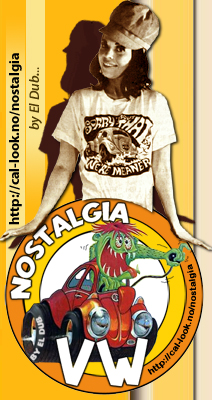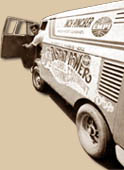
El Dub's Nostalgia corner.
Meetings, cars...
Treasures from the past.
Memories, people, meets.
H/Gas, I/Gas...
|
|

|
THE RISE AND FALL OF EMPI by R. MARSHALL WEBBER |
|
 |
 EMPI began with an idea that dovetailed nicely with the efficiency of design philosophy that made the Volkswagen Beetle a legend: don't waste anything. In the early 1950s, Joe Vittone was one of the first VW Dealers in the United States of America. His dealership, Economotors of Riverside, California, sold Volkswagens and other imports (including motorcycles) as economic transportation during a time when Detroit produced cars focused on luxury and power without regard to either efficiency or engineering elegance.
EMPI began with an idea that dovetailed nicely with the efficiency of design philosophy that made the Volkswagen Beetle a legend: don't waste anything. In the early 1950s, Joe Vittone was one of the first VW Dealers in the United States of America. His dealership, Economotors of Riverside, California, sold Volkswagens and other imports (including motorcycles) as economic transportation during a time when Detroit produced cars focused on luxury and power without regard to either efficiency or engineering elegance.
As a dealer and repair shop, Vittone's dilemma was a simple one: the valve guides on the early 36hp Volkswagen were frequently the first part of the engine to fail. Volkswagen of America's (VWoA) policy on these failures was dismissive: if the valve guides are shot, scrap the whole cylinder head. Unlike the post-war European frugality, VWoA was thoroughly disposable in it's philosophy, going so far as to toss a very serviceable component for the failure of a 50 cent part.
Joe Vittone adhered to the 'Old World' design philosophy better than his supplier did, by making a simple tool that would allow the valve guides to be pressed out and replaced, thus saving the cylinder head and a lot of money for the consumer. Not surprisingly, this tool became very popular with engine rebuilders and mechanics as it allowed the economical repair of the head with only 30 minutes of shop time required for the valve guide refit.
 To sell the valve guide tool kit, Vittone created European Motor Products, Incorporated (EMPI) in 1954.
To sell the valve guide tool kit, Vittone created European Motor Products, Incorporated (EMPI) in 1954.While it's initial goal of selling an inexpensive valve kit was modest, Joe dreamt bigger dreams. The domestic automotive industry of the early 1950's was characterized by the unremitting ideal of 'more power', an ideal apparently at odds with the minimalist nature of the Volkswagen. "Conventional Wisdom" dictated that VWs were people movers, not hot-rods, but there were signs from the Continent that it didn't have to be that way, and Joe saw them. Okrasa had done well selling performance parts for the VW and for the Porsche 356 in Europe. Why not here?
Over the next several years, Vittone added Okrasa and Judson components to his catalog and watched EMPI grow as VW owners discovered that owning a Beetle didn't have to mean owning a slug. In 1958, Joe Vittone started importing Austrian Denzel products because Denzel machined their parts from aluminum alloy making them the 'Swiss watch' of performance parts. EMPI also produced an anti-sway bar in 1958 that substantially improved the Beetle's cornering performance. While such a device was hardly new (both the Porsche 356 and the VW Karmann Ghia used them), no one had ever fitted one to a Beetle. Volkswagen AG (Germany) would eventually add the anti-sway bar to the Beetle as a factory item, but Joe Vittone is credited with doing it first, much to the delight of his customers.

Above picture : EMPI 36 HP Remanufactured Engine - G. Miller
Unlike the anti-sway bar, however, Vittone's Camber Compensator was a true innovation: a rear stabilizer that kept the rear wheels of a swing-axle transmission from 'tucking' under the body of the car during hard cornering. A decade later, in 1970, Volkswagen Greats magazine (not associated with VWoA) credited this EMPI invention with offering the Beetle the handling characteristics of a Porsche: "[w]ith EMPI's GTV modification, a Volkswagen can claim any mass-produced sports car in the world as it's peer." These products quickly moved EMPI from being a street performance and appearance retailer (though many of the EMPI catalogs remained top heavy with dress-up items) to approaching the automotive marketing holy grail: racing products.
In the early 1960's, the drag race phenomenon was moving from the informal (and illegal) wide roads of Southern California to privately owned racetracks and drag strips where the sport could be pursued in a sanctioned environment with less danger to bystanders. While American domestic models had a source for high performance components since the 1940's (many of them from the factory), Volkswagen AG and VWoA provided none and had no intention of providing any as the concept of a 'Race Bug' didn't square with the corporate marketing campaigns of the era.
Right picture : EMPI Display Engine circa 1964-1965 - G. Miller. Note the bright red car in the background... Awesome picture...
The American manufacturers poured a lot of money into racing, as it was where their bragging rights were earned, and again, EMPI picked up the ball that VWoA had dropped. To further cement the EMPI name in Volkswagen racing circles, Vittone changed the name of EMPI to Engineered Motor Products Incorporated, because he wanted to emphasize the research and development of new products designed in-house for exclusive sale. Vittone did not stop selling other manufacturer's products, however. In 1963, he visited the UK where he discussed a mutually-beneficial deal with Graham Hill, a world class race car driver and future winner of the 1966 Indianapolis 500. Hill owned Speedwell, an automotive performance developer and manufacturer of parts for European and British sports cars, most notably the MG. Vittone wanted access to the inner sanctum of real racing components. The number one gleam in Vittone's eye was the Speedwell BRM, a 90% pure magnesium wheel that provided a 40% weight reduction over the stock steel wheel.
 Left picture : The Inch Pincher being prepared for the 1964 Nassau VW Grand Prix - G. Miller
Left picture : The Inch Pincher being prepared for the 1964 Nassau VW Grand Prix - G. MillerThe BRM became the proverbial Holy Grail of racing accessories and to this day they command some of the highest prices in the racing and show car world because of their value and scarcity. Both sides came out of the deal smiling: Hill was given the rights to manufacture EMPI products at the Speedwell plant for distribution in the UK and Europe, while Vittone secured the distribution rights for the Speedwell line in the USA and beyond. Joe left behind a VW at Speedwell to aid in the development of a Stromberg carburetor kit, and returned to California ripe for the racing scene. Joe decided that the best jump-start for EMPI racing was to come to an arrangement with Dan Gurney, a customer Joe had once sold a Porsche Speedster to. Gurney was a genuine racing talent, and Vittone had turned his eye to the VW Grand Prix to be held in the summer of 1963 in Nassau. Joe's son, Darrell, owned a 1956 oval window Beetle and it was pressed into service as the racing vehicle. No engine modifications were allowed in this race, so Darrell balanced the 36 HP engine to exacting tolerances, allowing the 36 HP design to 'be the best it could be.
 Some of EMPI's racing stable, as captured on the cover of the October '65 issue of Foreign Car Guide.
Some of EMPI's racing stable, as captured on the cover of the October '65 issue of Foreign Car Guide.
The race officials were so alarmed at the car's speed during pre-race trials that, 3/4 of the way through the race, they made Gurney cover the engine tachometer, claiming it gave him an unfair advantage. It didn't matter, as the EMPI race car, piloted by Gurney, deftly won the 1963 Nassau VW Grand Prix. The next year of racing found Gurney back in the driver's seat, but the rules had changed to permit minor engine modifications. Dean Lowry, now a member of EMPI (and future driver of the Deano-DynoSaur) carefully ported and polished the valve seats and intake manifold and added some valve shims to give the engine some more pep. Perhaps too much pep. The 1964 Nassau VW Grand Prix was a disaster for EMPI, as the car so easily outpaced its rivals that the competition complained to the judges. Having never seen a stock VW move so fast, the judges disqualified the EMPI sedan for running "non-stock valve springs", thus handing over the winner's trophy to the second place driver, AJ Foyt. The ruling disgusted both Dan Gurney and Joe Vittone, Joe discovering that he didn't like racing politics as much as racing itself and returned the car to Darrell as his daily driver. By this time, Dean Lowry, who had worked for Vittone at Economotors on and off for a few years, wanted his own crack at racing the car that he had 'made go too fast.' With Darrell's backing, Lowry gutted the interior of the car to remove weight, built a 1700cc engine and took the EMPI Sedan to the drag strip. The EMPI Sedan soon made a reputation as a Chevy killer, easily blowing away vehicles with much larger engines. During the next year, Dean Lowry and Darrell Vittone would share driving duties of the newly rechristened Inch Pincher, so named because it got the most out of very few cubic inches. With tuning, the car began to run well into the 13-second bracket and when Darrell was called into the army, Dean Lowry upgraded the engine with a late model case that continued to stay well ahead of the competition. In 1966, Lowry fitted the car with a 1600cc engine coupled to a Shorrocks supercharger. Later, as NHRA racing rules became more flexible, the Inch Pincher was put on a diet and with many of the body components removed or replaced with Fiberglas or Plexiglas, eventually tipping the scales at only 1200 pounds.
The Inch Pincher is the most well known artifact from the EMPI era, but Joe Vittone did a lot more than just put the Inch Pincher on the map. In our forthcoming section on EMPI, you'll learn about the EMPI GTV and why it almost cost Joe his dealership (hint: when VWoA ain't happy, ain't NOBODY happy). How could EMPI go from Hero to Zero in only 4 years? Find out in parts 2 & 3...
E-mail : eldub@cal-look.com

